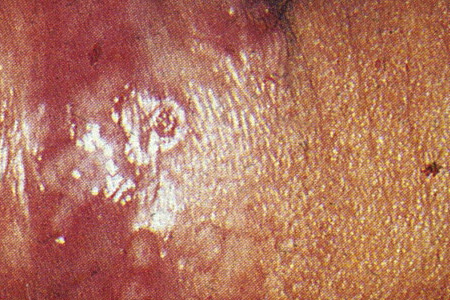Genital herpes: Signs and symptoms
Many people who have genital herpes never notice any signs or symptoms.
A mild case can cause a few herpes sores that are often mistaken for pimples or ingrown hairs. Because genital herpes often causes no symptoms or very mild ones, most people who have genital herpes don’t know they have it.
If you’re concerned that you or your partner could have genital herpes, here’s what you may notice:
The first outbreak
This usually occurs within two days to three weeks after having sex with someone who has genital herpes. The person doesn’t have to have sores to infect you.
Genital herpes sores
The sores usually appear on and around the genitals, anus, buttocks, hips, or thighs.

The first thing you may notice is flu-like symptoms:
Headache
Fever
Fatigue
Swollen lymph nodes, especially in your groin
Muscle pains
Some people say they feel tingling or an itch around their genitals or anus. This can last for up to 24 hours.
You may also notice a patch of red, swollen skin on or around your genitals or anus. Sometimes, this patch develops on the thigh or buttocks. If this appears, you may see:
Small blisters form on the patch.
The blisters break open, leaving painful sores.
The sores scab and completely heal, usually within 2 to 6 weeks.
Most people develop only a few sores, but some people have widespread blisters and sores.
During the first outbreak, some people also notice that they have pain or difficulty when urinating.
If you touch the sores, immediately wash your hands. This helps to prevent the virus from spreading to other parts of your body. If the virus gets in (or near) an eye, it can cause serious problems.

If you have HIV
Genital herpes is very common in people who have HIV (human immunodeficiency virus). If you have HIV and get genital herpes, outbreaks can be severe. You may need medicine to get rid of the sores. You’re also more likely to develop complications, such as meningitis or an inability to empty your bladder.
Repeat outbreaks
The virus that causes genital herpes never leaves your body. After the first outbreak, the virus moves to nearby nerves where it sleeps. You may never have another outbreak. It’s also possible that the virus will wake up, causing outbreaks from time to time.
Repeat outbreaks tend to be less severe than the first outbreak, and the sores clear more quickly.
Anyone can have repeat outbreaks, but you’re more likely to have them if you:
Are a man
Have a weakened immune system
Had a first outbreak that lasted longer than 34 days
If you get repeat outbreaks, these are most likely to occur during the first year. Your body will build up an immunity to the virus, provided you have a healthy immune system. As your immunity builds, the outbreaks should become less frequent. They may even eventually stop.
Repeat outbreaks are usually brought on by a trigger. Common triggers for genital herpes include stress, fatigue, illness, sex, and surgery. For some women, getting their period is a trigger.
During repeat outbreaks, some people notice that they develop warning signs, which tell them where the sores will appear. These warning signs include pain, tingling, itching, or a burning sensation. Warning signs can last for 24 hours.
Treatment can shorten how long you have an outbreak and reduce symptoms.
Related AAD resources
Images
References
Habif TP, Campbell, JL, et al. “Genital herpes simplex.” In: Dermatology DDxDeck. Mosby Elsevier, China, 2006: Card#56.
Madkan V Sra K, et al. “Human herpesviruses.” In: Bolognia JL, et al. Dermatology. (second edition). Mosby Elsevier, Spain, 2008:1075-6.
Marques AR, Straus SE, “Herpes simplex.” In: Wolff K, Goldsmith LA, et al. Fitzpatrick’s Dermatology in General Medicine (seventh edition). McGraw Hill Medical, New York, 2008: 1199-1204.
 Atopic dermatitis: More FDA-approved treatments
Atopic dermatitis: More FDA-approved treatments
 Biosimilars: 14 FAQs
Biosimilars: 14 FAQs
 How to trim your nails
How to trim your nails
 Relieve uncontrollably itchy skin
Relieve uncontrollably itchy skin
 Fade dark spots
Fade dark spots
 Untreatable razor bumps or acne?
Untreatable razor bumps or acne?
 Tattoo removal
Tattoo removal
 Scar treatment
Scar treatment
 Free materials to help raise skin cancer awareness
Free materials to help raise skin cancer awareness
 Dermatologist-approved lesson plans, activities you can use
Dermatologist-approved lesson plans, activities you can use
 Find a Dermatologist
Find a Dermatologist
 What is a dermatologist?
What is a dermatologist?